| Hollywoodland | Sex Files | Feb 26 2014 |

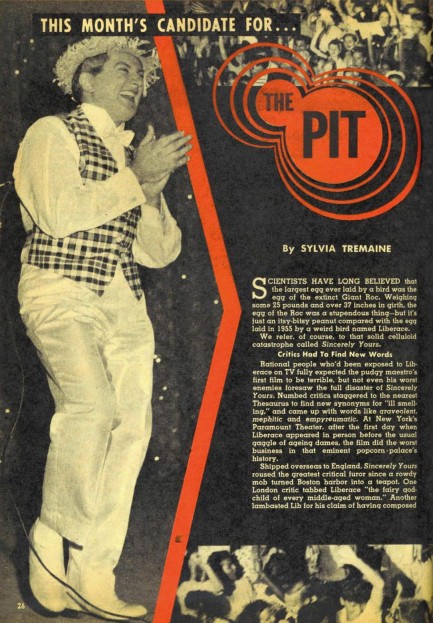
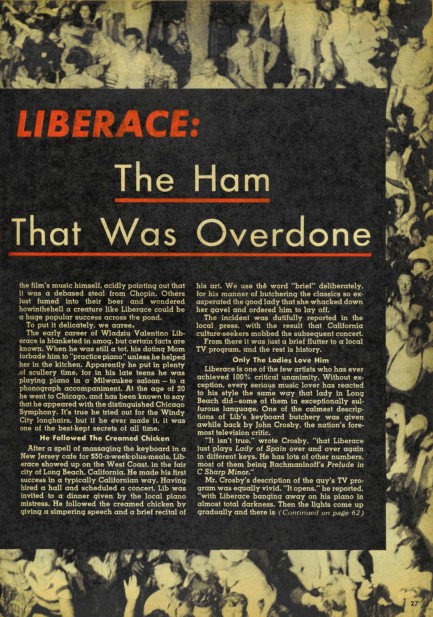
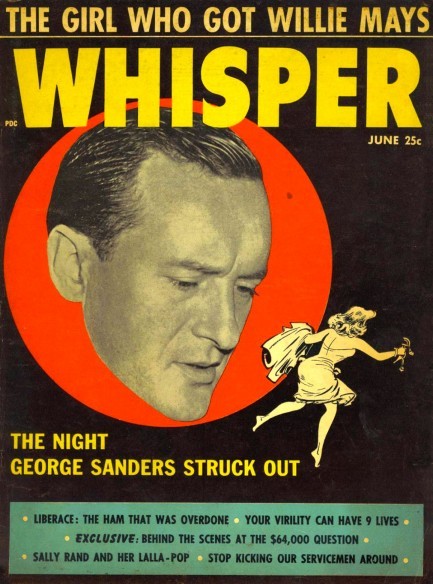 A long while ago we shared the cover of a 1956 Whisper featuring George Sanders. The same issue had an article on Liberace, and we’re returning to that today as part of our look at mid-century tabloid attitudes toward gay culture. In general of course, the tabloids were brutally insulting, using overt as well as coded language to get intimations of homosexuality across. Theoretically, when dealing with public figures they had to be somewhat cautious, but both Rave and Inside had in 1954 written stories insinuating that Liberace was gay, and in 1955 Suppressed and Private Lives did the same. In Whisper, a journalist writing under the name Sylvia Tremaine refers to Liberace as a “creature,” labels his speech as “simpering,” and describes his move to television this way: “From there it was just a brief flutter to a local TV program.”
A long while ago we shared the cover of a 1956 Whisper featuring George Sanders. The same issue had an article on Liberace, and we’re returning to that today as part of our look at mid-century tabloid attitudes toward gay culture. In general of course, the tabloids were brutally insulting, using overt as well as coded language to get intimations of homosexuality across. Theoretically, when dealing with public figures they had to be somewhat cautious, but both Rave and Inside had in 1954 written stories insinuating that Liberace was gay, and in 1955 Suppressed and Private Lives did the same. In Whisper, a journalist writing under the name Sylvia Tremaine refers to Liberace as a “creature,” labels his speech as “simpering,” and describes his move to television this way: “From there it was just a brief flutter to a local TV program.”
You’ll notice there’s deniability in all those words—Whisper could claim there was nothing defamatory in the language. Ridiculous, of course. Clearly the magazine was calling Liberace gay, and only a fool would claim otherwise, but defamation had not occurred to an extent that would stand up in court. Thus we see the joy of coded language. The same occurs in the U.S. today in certain media outlets with language directed at African Americans. The disparagement is clear, but deniable. Or for a cinematic example of coding, consider the Maltese Falcon and how the character of Joel Cairo is announced by flute trills on the soundtrack. Clear, and yet deniable. But in its Liberace article Whisper then throws deniability out the window with this: “Hollywood snickerers are wondering, in fact, if all the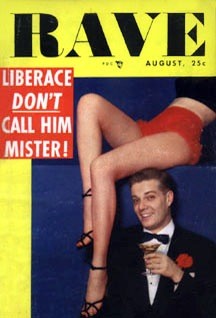 male hormones earmarked for the Liberace boys weren’t hogged by George, leaving Lee with only his nimble fingers.” That goes a bit beyond code, wouldn’t you say?
male hormones earmarked for the Liberace boys weren’t hogged by George, leaving Lee with only his nimble fingers.” That goes a bit beyond code, wouldn’t you say?
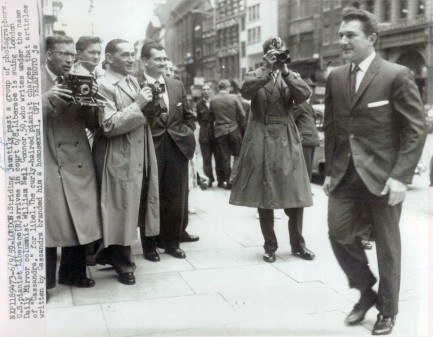 descriptive text, written for newspaper staff, is meant to simply get across the basic facts of the photos and is typically pretty dry stuff. But this describes Liberace as "the curly-haired pianist" and says his walk is "jaunty." Clear, but deniable.
descriptive text, written for newspaper staff, is meant to simply get across the basic facts of the photos and is typically pretty dry stuff. But this describes Liberace as "the curly-haired pianist" and says his walk is "jaunty." Clear, but deniable.| Intl. Notebook | Oct 15 2009 |


In Great Britain, controversy is building around an upcoming documentary depicting the loose journalistic ethics of London tabloids. Entitled Starsuckers, the movie is the brainchild of Taking Liberties director Chris Atkins and a group of colleagues, whose goal was to prove, in a comical way, that modern tabloids cannot be trusted to print the truth. To do this, they decided to anonymously call tabloid tip lines with fabricated stories. Their first test involved ringing up the Daily Mirror claiming to have seen singer Avril Lavigne passed out in a nightclub. The story appeared in the Mirror the next day, embellished with a few taunts to the effect that the singer was a “lightweight.”
In the next few weeks the Starsuckers team planted false stories in the Daily Express, the Daily Star, the Sun, and most of the other London tabloids, all using the same method—anonymous tips that were not in any way questioned. The planted stories often spread from one tabloid to the next with no evidence any attempts at corroboration had been made. One fabrication about Amy Winehouse’s hair catching fire spread to all the daily tabloids, a New York Post blog, and even to the Times of India.
Starsuckers promises to show not only that Rupert Murdoch-style sell-first/ask-questions-later journalism has infected the entire tabloid industry, but that it has spread to mainstream media, and in turn made consumers vulnerable to social, economic and political manipulation. The London tabloids have thus far declined comment on the claims made by Starsuckers and Atkins. Later this month the public will have an opportunity to judge the truth of these matters for itself when the movie debuts at the London Film Festival.




































































